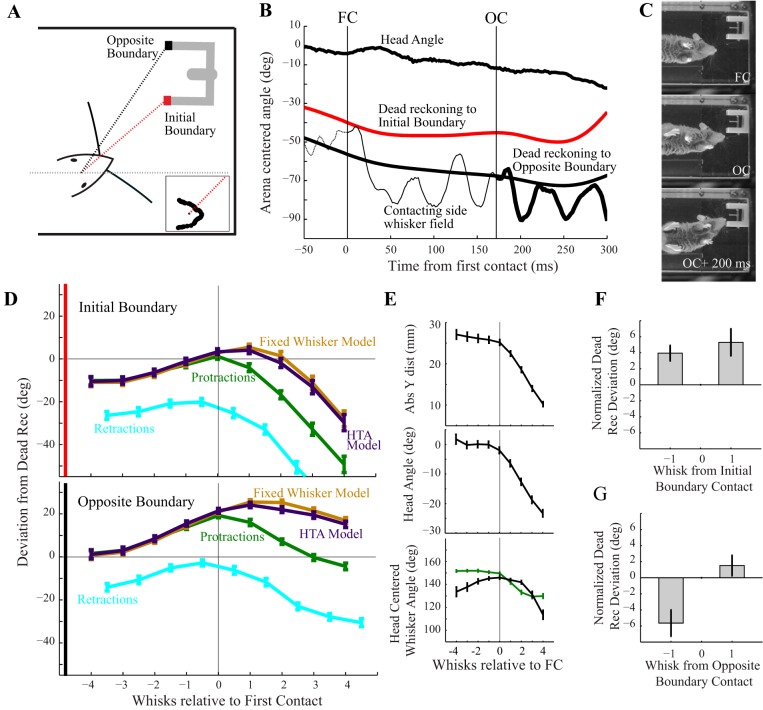Fig. 5.
Contact maintenance is an actively selected sensing strategy. A: dead-reckoning angles are defined by the line from the center of the head to a point of possible object contact, shown schematically by black and red dashed lines for the initial and opposite boundaries. The dead-reckoning angle is the arena-centered angle at which whiskers would point directly at the object, whether contacting or not, and accounts for contributions from both head translation and rotation. Note that since whisker angles are estimated near the whisker base, ignoring curvature (and in this figure are averaged across anterior whiskers), it is possible for whisker tips to make object contact at small deviations from the dead-reckoning angle. Inset: example frame of snout tracking with the calculated dead-reckoning line from the head to the initial contact point for that trial. B: an example trial shows that at first contact (FC; 0 ms; thin vertical line) the whisker angle (thin black curve) is close to the dead-reckoning angle to the initial boundary (thick red curve), but by the next whisk shifts closer to the opposite boundary (thick black curve). After contacting the opposite boundary (OC; ∼175 ms; thin vertical line, and thickened whisker angle curve), the protraction amplitude tracks the opposite boundary dead-reckoning angle. C: video frames corresponding to the example trial shown in B for times of FC, OC, and OC + 200 ms. Following opposite side contact, the snout trajectory passes very close to the near aperture boundary, resulting in the contralateral whiskers being mechanically forced backwards. D: trial averaged deviations from dead-reckoning are shown for peak protraction (green) and retraction (cyan) angles, in whisks around the first contact with the initial aperture boundary (n = 85, mean ± SE). Videos were vertically reflected as needed to make turns appear leftward. Contact maintenance with the first aperture boundary is not observed, as protraction angles move away from zero in the four whisks following contact (top). Contact maintenance is observed when the second aperture boundary is contacted (bottom; note alignment is still to first contact with the initial aperture boundary), as the green trace moves towards zero in the four whisks following contact. For comparison, a model whisker fixed relative to the head (brown) and a model whisker whose position is simulated to match published head-turning asymmetry (purple; see results) show that neither of these mechanisms is sufficient to account for the observed repositioning. E: head translation (top), arena-centered head rotation (middle), and whisker rotations (bottom; initially contacting whiskers in green, contralateral whiskers in black) are shown relative to time of first contact. Dead reckoning incorporates both head translation and rotation, to place the object in head-centered coordinates for direct comparison to whisker angle. Rightward turns were reflected as in D. F: summary of normalized deviations from dead reckoning for the whisk before and after initial boundary contact (the deviation during the contacting whisk is subtracted) show significant differences from dead reckoning on both the pre- and postcontact whisks and an absence of contact maintenance (n = 85, mean ± SE). G: same analysis as F for the whisks before and after contact with the opposite boundary shows small deviations postcontact and maintenance of contact angles (n = 85, mean ± SE).

